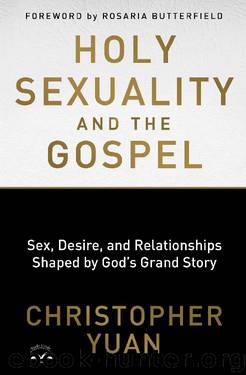Holy Sexuality and the Gospel by Christopher Yuan

Author:Christopher Yuan [Yuan, Christopher]
Language: eng
Format: epub
Publisher: The Crown Publishing Group
Published: 2018-11-20T00:00:00+00:00
Who Said, “It Is Good”?
The longest sustained discussion in Scripture on singleness is Paul’s teaching in 1 Corinthians 7. Paul’s words are crucial when examining a biblical theology of singleness. As often is the case, this chapter is not without interpretive challenges, beginning with the second half of verse 1: “Now concerning the matters about which you wrote: ‘It is good for a man not to have sexual relations with a woman.’ ”
Is this statement from Paul or from the Corinthians? The consensus seems to be that the second half of this verse is not from Paul; rather, he’s quoting from an earlier Corinthian letter. As can be seen, some Bible translations even place quotation marks around this phrase. However, inserting quotation marks is an interpretive decision since this punctuation is not present in the Greek manuscripts.
Those who think these are not Paul’s words believe a small group of overzealous Christians were disparaging sexual relations and marriage and Paul needed to correct their extreme asceticism. Much of the argument is based on the supposed implausibility of Paul penning this statement: “It is good for a man not to have sexual relations with a woman.”16
Why does this matter? If the Corinthians were promoting absolute abstention from sex and marriage, then Paul had to correct this error by encouraging them to marry and enjoy sex in marriage. This is good, right? Certainly, marriage and marital intimacy are good, but this implies that the opposite—chaste singleness in general—is not good. But, it’s good only for a few who are “called” with the “gift.”
Upon further examination, Paul’s letter bears little evidence that asceticism was an issue in this fledgling body of believers. The Corinthian believers boasted about incest and patronized prostitutes (5:1; 6:15), and Paul exhorted them to “flee” and “not indulge in sexual immorality” (6:18; 10:8). Also, this body of believers consisted of many who had been sexually immoral, adulterous, and practicing homosexuality (6:9, 11).
As it turns out, the church at Corinth was predominantly Gentile converts who most likely had yet to fully shed their secular understanding of marriage, sexuality, and singleness.17 In the Greco-Roman world, prostitutes provided pleasure, while wives simply provided children.
Wives and children were perceived to be a burden. In the first century, marriage and childbearing had gone out of vogue, while men continued to lead lives of debauchery. Some married men would have sex with prostitutes and not their wives, avoiding the responsibility of more legitimate children (7:2–5).18
Some have proposed that the sexually immoral and the sexually ascetic worshipped side by side in Corinth.19 But it’s highly unlikely that two diametrically opposite lifestyles could coexist in a moderately sized body of believers.20 And there’s no signal in the text that Paul switched from addressing the sexually immoral group in 1 Corinthians 6 to addressing the sexually ascetic group in 1 Corinthians 7. Furthermore, the use of porneia (sexual immorality) in 6:18 and 7:2 suggests continuity rather than discontinuity between the two chapters.
So what was the problem in Corinth? The sexually
Download
This site does not store any files on its server. We only index and link to content provided by other sites. Please contact the content providers to delete copyright contents if any and email us, we'll remove relevant links or contents immediately.
The 5 Love Languages: The Secret to Love That Lasts by Gary Chapman(9695)
The Space Between by Michelle L. Teichman(6891)
Assassin’s Fate by Robin Hobb(6162)
Wiseguy by Nicholas Pileggi(5707)
Everything Happens for a Reason by Kate Bowler(4700)
Gerald's Game by Stephen King(4607)
Pillow Thoughts by Courtney Peppernell(4241)
A Simplified Life by Emily Ley(4129)
The Power of Positive Thinking by Norman Vincent Peale(4029)
Harry Potter and the Prisoner of Azkaban (Book 3) by J. K. Rowling(3323)
Resisting Happiness by Matthew Kelly(3322)
Girl, Wash Your Face by Rachel Hollis(3250)
Being Aware of Being Aware by Rupert Spira(3247)
The Code Book by Simon Singh(3136)
The Secret Power of Speaking God's Word by Joyce Meyer(3067)
More Language of Letting Go: 366 New Daily Meditations by Melody Beattie(3001)
Real Sex by Lauren F. Winner(2986)
Name Book, The: Over 10,000 Names--Their Meanings, Origins, and Spiritual Significance by Astoria Dorothy(2960)
The Holy Spirit by Billy Graham(2914)
